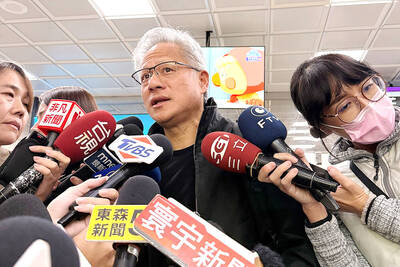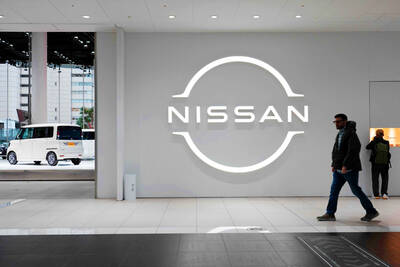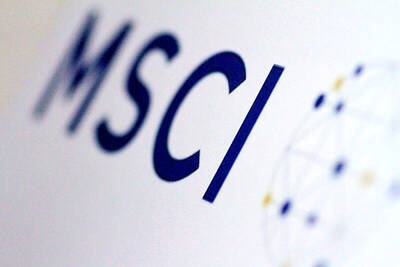Corporate culture at Taiwan Semiconductor Manufacturing Co (TSMC, 台積電) is what made the chipmaker a leading player in the global industry, a former executive said in an interview with California’s Computer History Museum.
“One of the really important reasons that TSMC succeeded” is the culture at the firm, where “if equipment went down at two o’clock in the morning, we just called an equipment engineer,” and the worker would not complain, said former TSMC joint chief operating officer Chiang Shan-yi (蔣尚義).
“We didn’t really do anything special, anything great, but we didn’t make any major mistakes,” when compared with competitors, such as United Microelectronics Corp (聯電) in Taiwan and Intel Corp, Chiang told the museum in March for its oral history project.
Chiang retired from the chipmaker in 2013.
Another reason for TSMC’s success was the decision to pivot to developing and manufacturing 12-inch wafers, when Intel and Samsung were focusing on 18-inch wafers in 2013, he said.
TSMC had talks with European chip equipment supplier ASML, whose priority at the time was advanced technology, he said, adding that the industry was “hot for 450mm wafers,” which TSMC was not pursuing.
However, ASML did not care whether “wafers [were] bigger or smaller,” as there was no cost saving, he said.
Chiang called his decision in 2016 to join Chinese chipmaker Semiconductor Manufacturing International Corp (SMIC, 中芯) “a mistake” and “foolish.”
“Before that, I had a pretty good image in Taiwan. That really hurt my image a lot. I didn’t expect that,” Chiang said.
Chiang said he asked TSMC founder Morris Chang (張忠謀) before taking the offer to become an independent member of the SMIC board of directors in 2016, and received his approval.
“You do something right, you do something foolish in your life. It was one of the foolish things I’ve done,” said Chiang, who now lives in the US, where he is a citzen.
SMIC could not purchase the latest manufacturing equipment to produce 7-nanometer chips because of US sanctions implemented three days after he joined the company, Chiang said.
He resigned as SMIC vice chairman in November last year.
“I have no plan to go back to work at this moment. That’s enough,” he said when asked if he is fully retired. “My next birthday, I’ll be 76.”

PERSISTENT RUMORS: Nvidia’s CEO said the firm is not in talks to sell AI chips to China, but he would welcome a change in US policy barring the activity Nvidia Corp CEO Jensen Huang (黃仁勳) said his company is not in discussions to sell its Blackwell artificial intelligence (AI) chips to Chinese firms, waving off speculation it is trying to engineer a return to the world’s largest semiconductor market. Huang, who arrived in Taiwan yesterday ahead of meetings with longtime partner Taiwan Semiconductor Manufacturing Co (TSMC, 台積電), took the opportunity to clarify recent comments about the US-China AI race. The Nvidia head caused a stir in an interview this week with the Financial Times, in which he was quoted as saying “China will win” the AI race. Huang yesterday said

Nissan Motor Co has agreed to sell its global headquarters in Yokohama for ¥97 billion (US$630 million) to a group sponsored by Taiwanese autoparts maker Minth Group (敏實集團), as the struggling automaker seeks to shore up its financial position. The acquisition is led by a special purchase company managed by KJR Management Ltd, a Japanese real-estate unit of private equity giant KKR & Co, people familiar with the matter said. KJR said it would act as asset manager together with Mizuho Real Estate Management Co. Nissan is undergoing a broad cost-cutting campaign by eliminating jobs and shuttering plants as it grapples

The Chinese government has issued guidance requiring new data center projects that have received any state funds to only use domestically made artificial intelligence (AI) chips, two sources familiar with the matter told Reuters. In recent weeks, Chinese regulatory authorities have ordered such data centers that are less than 30 percent complete to remove all installed foreign chips, or cancel plans to purchase them, while projects in a more advanced stage would be decided on a case-by-case basis, the sources said. The move could represent one of China’s most aggressive steps yet to eliminate foreign technology from its critical infrastructure amid a

MORE WEIGHT: The national weighting was raised in one index while holding steady in two others, while several companies rose or fell in prominence MSCI Inc, a global index provider, has raised Taiwan’s weighting in one of its major indices and left the country’s weighting unchanged in two other indices after a regular index review. In a statement released on Thursday, MSCI said it has upgraded Taiwan’s weighting in the MSCI All-Country World Index by 0.02 percentage points to 2.25 percent, while maintaining the weighting in the MSCI Emerging Markets Index, the most closely watched by foreign institutional investors, at 20.46 percent. Additionally, the index provider has left Taiwan’s weighting in the MSCI All-Country Asia ex-Japan Index unchanged at 23.15 percent. The latest index adjustments are to